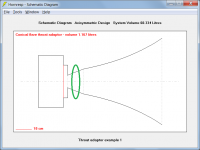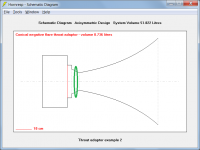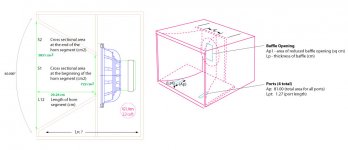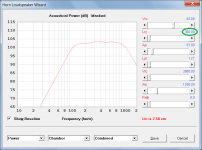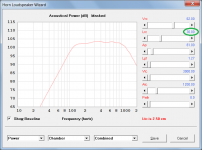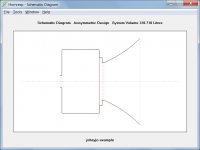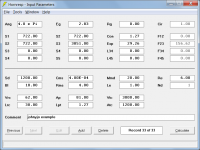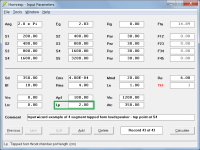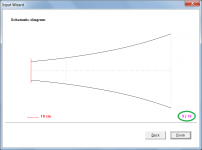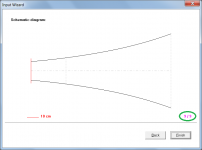And this?
Range("NUMBERS").NumberFormat = "#.###############"
Hi USRFobiwan,
I am not familiar with the above statement (I assume that is used in VBA) so I can't really comment on whether or not it would solve the problem.
In any event, as indicated earlier, the issue has now been addressed in the Hornresp code.
Kind regards,
David
... with the air space between the driver diaphragm and baffle being specified using Vtc and Atc, with Atc usually set equal to Sd.
In regards to using a smaller or restricted opening in the baffle (post# 7736), would these settings also apply when creating a straight horn for mid-bass applications?
... where baffle opening is entered under "Ap1" and its thickness (in cm) entered under "Lp".
In regards to using a smaller or restricted opening in the baffle (post# 7736), would these settings also apply when creating a straight horn for mid-bass applications?
... where baffle opening is entered under "Ap1" and its thickness (in cm) entered under "Lp".
As shown you can indeed neck down the driver to a throat chamber and then allow an opening for a throat to a horn.
In regards to using a smaller or restricted opening in the baffle (post# 7736), would these settings also apply when creating a straight horn for mid-bass applications?
... where baffle opening is entered under "Ap1" and its thickness (in cm) entered under "Lp".
Hi johnnyjo,
It all depends upon the design. For a straight-axis horn, Ap1 and Lp can be used in conjunction with a throat chamber to specify a conical throat adaptor if so desired.
Kind regards,
David
Attachments
Just one of the reasons why HR is the BEST speaker enclosure modeling software on the planet! We just need more segments to be the PERFECT software....hint hint...LOL!
verify measurements
Hey guys, I don't mean to hijack this thread with my lack of understanding. There are some hornresp examples out in the web that I could refer to, but some of the better ones with photos (for those of us visual people) have been lost. This also may help other newbs - which is good - and I'm hoping it will.
If you can look at the attached photo showing some measurements for hornresp, here is my question again with clarity about a reduced opening in the baffle along with ports in the horn.
* Ap1 is defined as the area of throat adaptor entry. Lp is throat adaptor length. So if I have a baffle with a smaller opening than the driver diaphragm the area of this opening should go under Ap1. And the length which is the thickness of the wood should go under Lp. Correct? But what if I also have ports in the horn. I would need a separate entry under Ap and Lpt. I don't think I can do that since the values between Ap1 and Ap go under the same entry field.
* About Lrc... The ports are not in the rear chamber. And there is area under and above the horn. Should I count this area? Not sure what to do here since the ports are in the front. The driver is very close to the back wall almost 3cm away.
Hey guys, I don't mean to hijack this thread with my lack of understanding. There are some hornresp examples out in the web that I could refer to, but some of the better ones with photos (for those of us visual people) have been lost. This also may help other newbs - which is good - and I'm hoping it will.
If you can look at the attached photo showing some measurements for hornresp, here is my question again with clarity about a reduced opening in the baffle along with ports in the horn.
* Ap1 is defined as the area of throat adaptor entry. Lp is throat adaptor length. So if I have a baffle with a smaller opening than the driver diaphragm the area of this opening should go under Ap1. And the length which is the thickness of the wood should go under Lp. Correct? But what if I also have ports in the horn. I would need a separate entry under Ap and Lpt. I don't think I can do that since the values between Ap1 and Ap go under the same entry field.
* About Lrc... The ports are not in the rear chamber. And there is area under and above the horn. Should I count this area? Not sure what to do here since the ports are in the front. The driver is very close to the back wall almost 3cm away.
Attachments
See post 7740 about the baffle opening. Regarding the 4 ports, you have to treat that section as a vented rear chamber or the whole enslosure as a compound horn where the rear horn is a straight flare. I'm on my phone so I can't post input screens to show both options.
@BP1Fanatic
I know where in the subwoofer section and i'm asking questions about regular horns. I must have missed post 7740, but it still references a tapped horn. Maybe I should review all data again.
I know where in the subwoofer section and i'm asking questions about regular horns. I must have missed post 7740, but it still references a tapped horn. Maybe I should review all data again.
Hi johnnyjo,
Correct.
Correct again.
In this case simply specify a two-segment horn, with the first segment becoming the throat adaptor with S1 = 722, S2 =722 and L12 (Con, Exp or Par) = 1.27.
The volumes (not areas) above and below the horn should be included in Vrc if they form part of the total air volume of the enclosure. Don't worry too much about the precise value of Lrc, just use a 'best guess' average - if the 'resonances masked' option is selected, it doesn't matter what the value is.
Kind regards,
David
Ap1 is defined as the area of throat adaptor entry. Lp is throat adaptor length. So if I have a baffle with a smaller opening than the driver diaphragm the area of this opening should go under Ap1. And the length which is the thickness of the wood should go under Lp. Correct?
Correct.
But what if I also have ports in the horn. I would need a separate entry under Ap and Lpt. I don't think I can do that since the values between Ap1 and Ap go under the same entry field.
Correct again.
In this case simply specify a two-segment horn, with the first segment becoming the throat adaptor with S1 = 722, S2 =722 and L12 (Con, Exp or Par) = 1.27.
About Lrc... The ports are not in the rear chamber. And there is area under and above the horn. Should I count this area? Not sure what to do here since the ports are in the front. The driver is very close to the back wall almost 3cm away.
The volumes (not areas) above and below the horn should be included in Vrc if they form part of the total air volume of the enclosure. Don't worry too much about the precise value of Lrc, just use a 'best guess' average - if the 'resonances masked' option is selected, it doesn't matter what the value is.
Kind regards,
David
Attachments
We just need more segments to be the PERFECT software
Nice try, but if Hornresp was perfect I would have nothing to do, and we can't have that 🙂.
Hornresp Update 4230 -170827
Hi Everyone,
CHANGE
The default Input Wizard throat chamber port length Lp has been changed from 20 cm to a more realistic value of 2 cm.
BUG FIX
The Input Wizard final page total for a back-loaded horn with no throat chamber was being shown as 10 rather than 9. This has now been fixed.
Kind regards,
David
Hi Everyone,
CHANGE
The default Input Wizard throat chamber port length Lp has been changed from 20 cm to a more realistic value of 2 cm.
BUG FIX
The Input Wizard final page total for a back-loaded horn with no throat chamber was being shown as 10 rather than 9. This has now been fixed.
Kind regards,
David
Attachments
Am I being too anal by stating the 2 cm should be 1.91 or 1.905 cm (0.75 in)?
The survey says......
We agree with the first part of the statement😀
The survey says......
We agree with the first part of the statement😀
🙂.
Hi Everyone,
CHANGE
The default Input Wizard throat chamber port length Lp has been changed from 20 cm to a more realistic value of 2 cm.
BUG FIX
The Input Wizard final page total for a back-loaded horn with no throat chamber was being shown as 10 rather than 9. This has now been fixed.
Kind regards,
David
Lp = 2.00
the data input shows 2.00 indicating 3 significant figures.Am I being too anal by stating the 2 cm should be 1.91 or 1.905 cm (0.75 in)?
Are you stating that you input 1.91 or 1.905? These are the same to 3 sig fig.
But that is not the same as 2.00
Where has the difference gone?
Last edited:
the data input shows 2.00 indicating 3 significant figures.
Are you stating that you input 1.91 or 1.905? These are the same to 3 sig fig.
But that is not the same as 2.00
Where has the difference gone?
Hi AndrewT,
I think it is just a "tongue-in-cheek" comment, not to be taken too seriously 🙂.
As a resident of the United States, BP1Fanatic lives in an imperial-unit world, not a metric one. He would be more comfortable seeing the exact metric equivalent of 3/4 inch as the default value (0.75 * 2.54 = 1.905 cm). The closest that we could get in Hornresp is 1.91 (1.905 rounded to 2 decimal places), but it's not going to happen 🙂.
Kind regards,
David
The metric equivalent of 3/4" plywood and 3/4" board is 18mm here in the UK.
As far as I have seen and bought, 19mm and 20mm are not available.
I have seen both 9mm and 10mm for board thicknesses.
But you as the customer can ask for what you need and I'm sure the supplier will either find it, or tell you where to go.
As far as I have seen and bought, 19mm and 20mm are not available.
I have seen both 9mm and 10mm for board thicknesses.
But you as the customer can ask for what you need and I'm sure the supplier will either find it, or tell you where to go.
- Home
- Loudspeakers
- Subwoofers
- Hornresp
